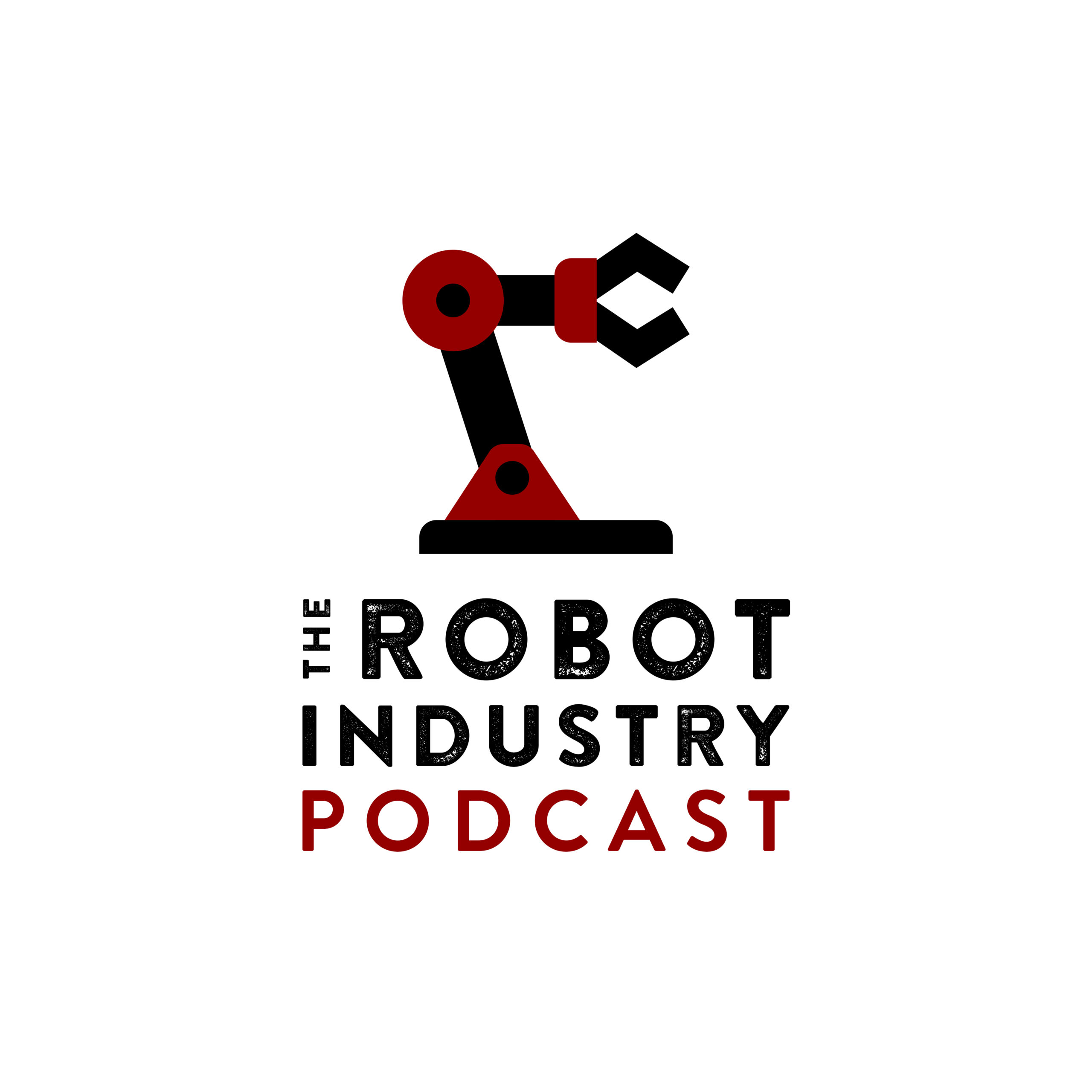Speaker 0 00:00:02 This is the robot industry podcast, July 27th. I'm here with Victor from Royal tire. And so I'm going to go into my notes. Oh no, we're going to do, we're going to do the hook first, so, and you can do it a couple of times. So go ahead, Victor.
Speaker 1 00:00:24 Yes, we are rubber tire and we are driving the future of automotive repair with robots and software, starting with the tire changing process.
Speaker 0 00:00:35 Hello everyone. And welcome to the robot industry podcast. We're glad you're here. My name is Jim Beretta and thank you for subscribing we're broadcasting from actually, where, what city are you from? I was going to ask you this spectrum,
Speaker 1 00:00:49 Uh, Plymouth, Michigan.
Speaker 0 00:00:54 I'm going to do that again, Chris. We are broadcasting from London, Ontario, and from Plymouth, Michigan. And my guest today is Victor, Victor. Oh my God. I don't know your last name. The Rolfing. Yep. My guest today is Victor <inaudible> from robo tire and welcome to the podcast, Victor.
Speaker 1 00:01:20 Well, thank you for having me. It's a pleasure to chat with you.
Speaker 0 00:01:25 Maybe you could just start with what you're doing and maybe how you got started.
Speaker 1 00:01:30 Sure. So what we're doing is we're building a platform for automating vehicle maintenance. Um, we're starting with tires because they're consumable and they're kind of the thing that doesn't change with the changing of vehicle types, moving from internal combustion engines to electric, and then eventually to autonomous that's and they're on the outside. So they're easiest to automate, right? Instead of trying to get under the hood. And that's where we're starting with. Um, before I dive in a little further, my background is in the robotics space. So I've got about 12 years building robots for Tesla space, X, apple, zoom, pizza, cafe X, and name it. And I've made these industrial robots do crazy things. Uh, this is my second company. First company was a battery pack company. Um, and how I got into this, you know, sadly enough, my wife needed new tires. I sat at a shop for three hours, hated every minute of it and thought, Hey, there has to be something better than a human doing this. Right. And that's how I started this.
Speaker 0 00:02:40 This just fits right into the dull, dangerous, dirty work, for sure.
Speaker 1 00:02:46 Correct.
Speaker 0 00:02:48 In our, a call earlier, you mentioned that you went into Y Combinator and how important was that?
Speaker 1 00:02:55 I think that was so why see, everyone knows why C right. You know, Bracks came out of it. Uh, Cruz came out of it and Airbnb came out of it. Um, you know, I think it's one of those things, especially for like a hardware company, because there's not a lot of hardware companies that go through YC. It's kind of like one of those stamp of approval and, you know, from a startup perspective, anything I can do to make sure this doesn't fail, I'm going to try to do right. If that, you know, getting into YC gives me, uh, you know, 1% better chance I'm going to do it. But I think the real benefit of YC is the network and the ability to communicate with some really outstanding entrepreneurs and founders and get insight that, you know, if I didn't have that community, I probably wouldn't know those answers.
Speaker 0 00:03:43 You know what, sometimes it's a network that you have for sure. Victor, what is the value proposition then of Romo tire
Speaker 1 00:03:52 Kind of like, what'd, you ha you stated, right. Which is replacing this, um, you know, repetitive manual tasks of lifting a tire eight hours a day. You know, each tire on average is about 50 pounds. Um, the industry average, now some people may poke holes in it, but the industry average is about, uh, an hour for a set of four tires. And again, with humans, you can go really quick. In the beginning, you can add more people. They'll try to tail off by five o'clock that time gets longer. So right now what we're doing, we're live in a current shop and we're doing a set of four tires in 15 minutes from Poland to pull out. So the value prop from a shop's perspective is, you know, we say augment your workforce, basically giving a shop, the most sophisticated tool that they could buy and putting in their shops to help them, you know, service customers, faster increase margins, increase revenue. And then from the consumer side, it's actually like being able to definitively know when your car is going to get done. Right. So if you show up at 10, you're going to be out by 10 30. It's not going to be oh 3, 4, 5. O'clock right.
Speaker 0 00:05:07 Yes. And Victor, we were talking on the podcast just the other day about, uh, attracting or chaining labor. So this is something for the car dealerships and for the service depots to consider as a labor strategy.
Speaker 1 00:05:24 Correct. And that's part of my goal here is to kind of bring the new breed of technicians. So we're working with some of the, um, trade schools here in Michigan area to kind of train the new breed of mechanic, to re-energize people, to be a mechanic. Uh, you know, tires in particular is an entry-level job. That's got high turnover, you know, when you stack it up between changing a tire, driving for Uber or flipping a hamburger, which one you don't think people are going to do. Right. So then you pair that with, you know, a Tesla now it's like 50 plus computers on it. You're also becoming more of like software diagnostic more than turning wrenches. So yes, we're doing that to re energize the mechanic to come say, come be a robot technician instead of being a Carmen tech mechanic. But you're going to know you're going to have to maybe fix a car to
Speaker 0 00:06:19 Yes. And come work with robots. Right, right. Yeah. That's a very easy value proposition. So how does the system work? Okay.
Speaker 1 00:06:26 So a high level without getting into too much of our patents, right. Um, basically the car comes in, um, we scan the vehicle and then it is driven over our automated lift. We have an automated lift that lifts the car. So the pitch there is that a car will never fall off the lift again. Um, it picks up the vehicle. Then we have little robots that come and again, use machine vision to identify lug nuts style type X, Y, Z. We remove the lug nuts. We have a larger robot that comes in, removes the tire. Uh, we then integrate, uh, existing third-party tire, changers, and bouncers to do the D mounting process mounting process balancing. And then, uh, back on the car and lug nuts, all tightened up. So, you know, this task that used to be all manual at our current step, probably about 85% is automated. Again, there's still some that isn't, but that's just because we want to get product out to a customer's hand and get real world feedback before trying to automate it a hundred percent.
Speaker 0 00:07:45 And of course you get data too, right? You can find out who's doing what, what kind of cars, how long it takes.
Speaker 1 00:07:51 Correct. That's kind of like the hidden gem, I guess, is, you know, you take a manual task that is very labor intensive to record data now to a robotic tasks that is equipped with vision sensors and all that. And just the amount of data that we collect, uh, regarding lug nuts vehicles, um, weather conditions of the vehicle and how it affects parts. It's kind of, it's kind of endless of what we could go after. And that's why we want to build a platform and not just like a tire changing robot.
Speaker 0 00:08:27 Well, I think a tire changing roles is a cool idea, but of course a platform is so much more attractive to investors and to, um, and people who are buying your equipment.
Speaker 1 00:08:36 Correct. And we kind of changed the, you know, people have talked about it, but our default business models around math or robot as a service. So as we continue to develop and bring out more features like next up is brakes after this and then suspension. Um, and then some more vehicle inspections. So digital vehicle inspection. So it's kind of like, oh, you want this service or that service is just kind of adding different, um, packages, more like software than it is hardware.
Speaker 0 00:09:06 So if I'm a dealer or I'm a, uh, service station, I just come to you and say, Hey, come here's, here's the bait, put some equipment in
Speaker 1 00:09:18 Yes. High level. Yes. I mean, there's some consideration because we are bigger than a normal bay. Um, we're about two bays worth from a size perspective, but we do like three to four X, the throughput. So it kinda offsets a little bit. Um, but yes, high level a shop will come to us saying, Hey, you know, I want to run a tire system. We do floor layouts. And then we kind of gear them up and ship. Um, our facility here, it's still being built, but in Plymouth we currently have about 110,000 square feet. Um, uh, warehouse and office. The target is to be able to produce about a hundred of these a year and hope maybe we'll get there next year, but, um, yeah, that's the high-level process.
Speaker 0 00:10:08 And so what do the, I was going to say payback, but because it's a R a S system, how does that work from a dealer's perspective?
Speaker 1 00:10:18 Um, it depends on the dealer, but it mainly loses what we try to do. And our numbers will fluctuate based on tire volume, but we try to make it so that it's almost apples to apples saying, Hey, I paid Johnny to change tires. I'm going to pay Rover tire the same thing. Right. That's kind of high level what we try to strive for.
Speaker 0 00:10:41 And one of the neat things I think is everything gets digitized. So I know that these tires are put on with a proper torque.
Speaker 1 00:10:48 Correct. Right. There's that there's, um, the ability to not, I would S we can't use guarantee because legal will not like me that, but just the ability to, to have confidence that a wheel's never going to come off of a tire. Right. Because there's, it's a rare case, but, you know, if a tire comes flying off of the highway at 80, that's a liability on the shop. So, you know, there's other factors besides just the workforce augmentation, it's work comp policies, it's liability insurance that the shops have to take, which our systems could hope to reduce.
Speaker 0 00:11:32 So how are these conversations going with your prospective customers?
Speaker 1 00:11:39 Uh, really well, uh, we've actually accelerated, um, post pandemic, but right now we have one system live in California. Now that was kind of our test bed. And they've been a really great first adopter. Um, for us, we have 13 systems on order another, one's leaving here in about two weeks. They range from, I can't say the name yet because we haven't made the announcement yet, but it ranges from independent shops to, um, oil change franchise to big box retailers. So we cover the gambit. Um, we also have two military contracts, uh, both with the air force and with the army for our system. So we go wide and our customer base is very wide.
Speaker 0 00:12:29 Well, you can imagine some of these huge tires that go on tractors or go on, uh, big mining vehicles and such. So it's very exciting opportunity for you.
Speaker 1 00:12:38 Correct. And right now, like the core feature set for our system right now is passenger vehicles. But early next year, we'll bring out a solution to big rigs as well.
Speaker 0 00:12:52 That's very exciting. So I'm assuming you're talking to all your bulls-eye customers.
Speaker 1 00:12:58 Yes. There's a, there's a lot of, uh, the big chains that we're talking with. Um, we, again, I can't tell you who it is, but we have one of the largest, we have one of the largest, uh, players in the states, right. That is our, uh, customer. And then, um, you know, if anyone wants to see it, I want to do a little plug here. Um, you're probably familiar with the SEMA conference. Uh, the seamless expo in Vegas robo tire will have its full system there on display. So if anyone wants to come see it and you happen to be at the SEMA show, um, stop by there. And there could be a possibility that we may be at CES as well. So there is going to be some opportunities to see these systems in person.
Speaker 0 00:13:46 Well, no, that's very exciting. So you, you kind of mentioned at the beginning, some of your next big challenges and, and its its brakes and its other products, One system be able to do with them all or is, or you will come into a separate unit for that.
Speaker 1 00:14:02 The hope is that we can again, maybe do an end of arm tool change, or we haven't really designed it, but the goal is to be all in one unit. So it's a basically fully equipped bay, um, you know, breaks. Anyway, we gotta try to watch where the market is going, right again, with electric vehicles, are you doing brakes? Are you doing full motor swap outs? Right? What where's the, or batteries. Right. Um, I think right now our bigger challenges are around the environmental. So, you know, what do you deal with during winter it's rust, right? What do you deal with, um, vehicles that have been sitting for awhile, right. Post pandemic vehicles that haven't been driven a lot, you know, how does that affect certain aspects of the vehicle?
Speaker 0 00:14:53 No, that's very exciting. It's really, really interesting. And I look forward to catching up with you, some of these trade shows and so Victor, um, how do people get ahold of you?
Speaker 1 00:15:04 Uh, there's many ways. Uh, we can find me on LinkedIn. I'm always happy to connect. Um, the default, if you want to get ahold of row tire, it's just info at robo tire. Um, that gets forwarded to all of us and, uh, those are the two easy ways to find us
Speaker 0 00:15:21 Well. That's great. And did, have we missed out anything? Is there anything else that you want to talk to with the audience?
Speaker 1 00:15:29 Um, not about robo tire. I mean, I'm always happy again, my background is in the robotics space, so always fun to add my 2 cents, um, about the robotics face of where I think things are going. If you don't have any other questions about robo tire.
Speaker 0 00:15:47 Well, you know, I'm very excited for you. I think it's going to be a lot of fun and, uh, you'll be able to solve a lot of the challenges that we're facing today with the labor crisis.
Speaker 1 00:15:58 Correct. And you know, the one interesting stat there's about 36,000 technicians short right now, um, to service the industry and, um, you know, just the pandemic has actually made it a lot worse because yes vehicles me and you are probably not driving as much, but our fleets are driving a lot more so that Amazon delivery vehicle, you know, the door dashes of the world miles are going up.
Speaker 0 00:16:27 Absolutely. Well, Victor, thank you so much for spending some time with us and telling us a little bit about robo tire.
Speaker 1 00:16:33 Okay. Thank you.
Speaker 0 00:16:35 Our sponsor for this episode is Earhart automation systems Earhart's builds and commissions turnkey solutions for their worldwide clients. With over 80 years of precision manufacturing, they understand the complex world of robotics, automated manufacturing and project management, delivering world-class custom automation on-time and on-budget contact one of their sales engineers to see what Earhart can build for you. I'd also like to thank our partner. <inaudible> the association for advancing automation. They're the leading automation trade association for robotics, vision and imaging motion control and motors and industrial artificial intelligence technologies. I'd like to thank painted robot. They build an integrate digital solutions. They're a web development firm that offers SEO and social marketing and can set up and connect CRM and other ERP tools to unify marketing sales and operations. And you can find
[email protected]. And if you'd like to get in touch with us at the robot industry podcast, you can find me Jim Beretta on LinkedIn. We'll see you next time. Thanks for listening. Be safe out there. Today's podcast was produced by customer attraction, industrial marketing, and I'd like to thank my nephew, Chris gray for the music, Chris Colvin for audio production, my partner, Janet and our partners, a three painted robot into our sponsor Earhart automation systems.


